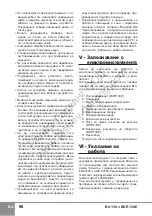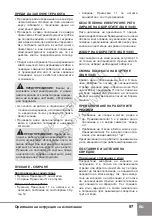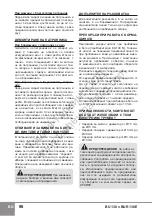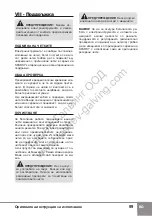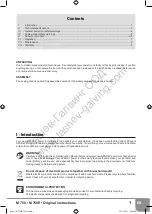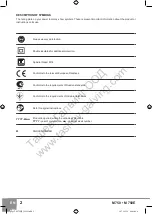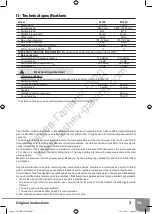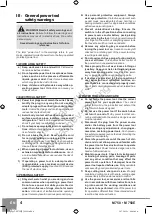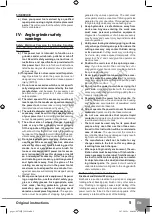
8
M 750 • M 750E
EN
MOUNTING THE WHEEL GUARD
Before performing the following operations switch the
machine off and withdraw the plug from the socket.
1. Mounting the wheel guard
- Open the fastening lever (17) and loosen screw (18)
if necessary.
(Fig.1)
- Place the wheel guard so that the cotter (16) will
coincide with the groove (19) and press the wheel
guard down to enter the groove (20) around the
bearing bed.
(Fig.2a, b)
- Tighten the screw (18) to eliminate the clearance
between the guard bracket and the bearing bed
enough to ensure slight relative rotation between
them.
- Rotate the wheel guard to the desired position.
- Close the fastening lever (17) to fix the wheel guard.
- If necessary, repeat the operation for eliminating the
clearance between the guard bracket and the bear-
ing bed.
2. Rotating the wheel guard to a new operating po-
sition
- Open the fastening lever (17).
- Turn the wheel guard to the new operation position.
- Close the fastening lever (17).
MOUNTING THE WHEEL
Secure spindle (1) by depressing the spindle lock button
(9) provided on the gear case.
WARNING:
Never press button (9) while the
spindle is still rotating!
- Place the support flange (3) with the grooves down
-
ward.
(Fig.3)
- Place the wheel (4) strictly upon the support flange
with the inscriptions facing down.
(Fig.4)
- Place the fixing flange (5) with its flat side toward the
wheel (4) and fasten it by hand. Place the two-pin
spanner into the openings of the fixing flange (5).
(Fig.5)
- With the spindle lock button (9) depressed tighten
reliably the fixing flange by the two-pin spanner.
(Fig. 6a, b)
After replacing the wheel operate the machine with the
new wheel in no load mode for one minute. Vibrating or
otherwise improperly rotating wheels must be replaced
immediately and discarded.
Cup brushes (10) are screwed directly on spindle (1)
by means of an open-end spanner. (Check if the brush
thread length is sufficient to accept the spindle thread.)
Sanding and polishing with abrasive sanding disks is
accomplished by means of plastic rubber backing disk
(pad) (11), under which sandpaper or polishing bonnet
(12) is mounted. Place the plastic backing pad (11) on
the support flange (3) and secure it with lock nut (13),
delivered with the machine. In case the flexible back
-
ing pad is equipped with a flange, the pad is screwed
directly onto the spindle by a wrench without using the
fixing flange (5). The pad with flange may be a resin filled
sponge, foam polyurethane sponge with plastic insert for
the nut with hook-and-loop fastening to the sandpaper or
the bonnet. After replacing the pad perform a trial run for
one minute at no load. Vibrating or otherwise improperly
rotating pads must be replaced immediately.
AUXILIARY HANDLE
Normally the auxiliary handle is screwed on the machine
left side. It can be mounted also on the machine right
side if this is more convenient for the operator.
SWITCHING ON - SWITCHING OFF
Switching on:
Push the back end of the ON/OFF switch
(7) down and then forward in the direction of the arrow
until its front end will sag, thus fixing itself.
Switching off:
Press the back, lifted end of switch (7)
and release it to return in its initial position.
ADJUSTING THE ROTATION SPEED (M 750E)
The rotation speed can be varied smoothly by turning
electronic regulator (8), placed on the rear of the grinder.
In the table below the recommended regulator positions
for the different areas of applications are specified:
Area of application
Regulator
position
Plastics grinding with plastic disk
and abrasive cloth (paper)
A - C
Wood grinding and removing
lacquer and dye coatings
B - D
Metal grinding with plastic disk and
abrasive cloth (paper)
C - F
Dust removing with cup brush
D - F
Rough cleaning, metal or stone
cutting
G
Polishing with plastic disk and
polishing jacket
A - B
Model M 750E is equipped with electronic device for
smooth rpm adjustment.
The electronic device supports smooth rpm adjustment
for choosing the appropriate speed for grinding, cutting
and polishing different materials.
TURNING THE MACHINE CASE
The machine case can be turned to 90° or to 180°. The
first way of mounting is implemented when the machine
is used mainly for cutting, and the second - in case the
operator works better with his left hand. In both cases the
case turning must be carried out in a specialised service
centres for SPARKY power tools.
RECOMMENDATIONS
When cutting, do not apply pressure, do not oscillate the
wheel. Work with moderate feed rate, suited to the mate-
rial to be machined.
The direction of cutting is very significant. The machine
must always be fed against the direction of wheel rota-
tion. Otherwise, danger exists for the wheel to be forced
uncontrolled out of the cut.
(Fig.7)
pages-M 750[E]-2012.indd 8
10.7.2012 г. 08:42:10 ч.
Та
ше
в
-
Га
лв
ин
г
ОО
Д
www.tashev-galving.com

